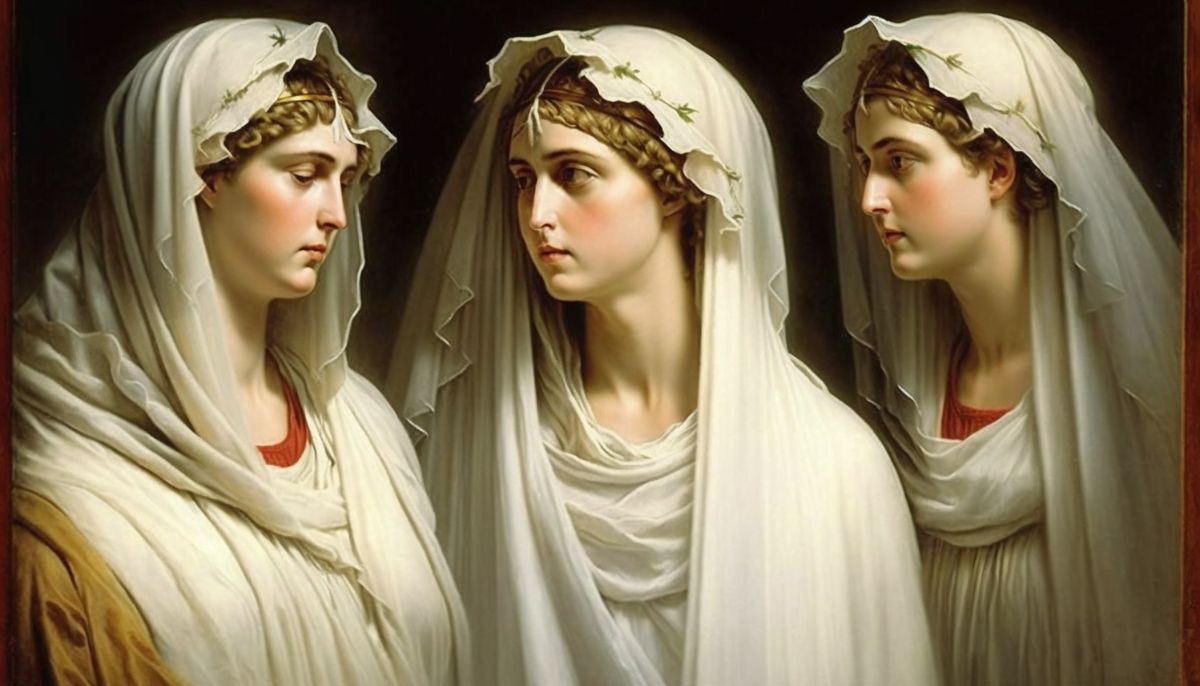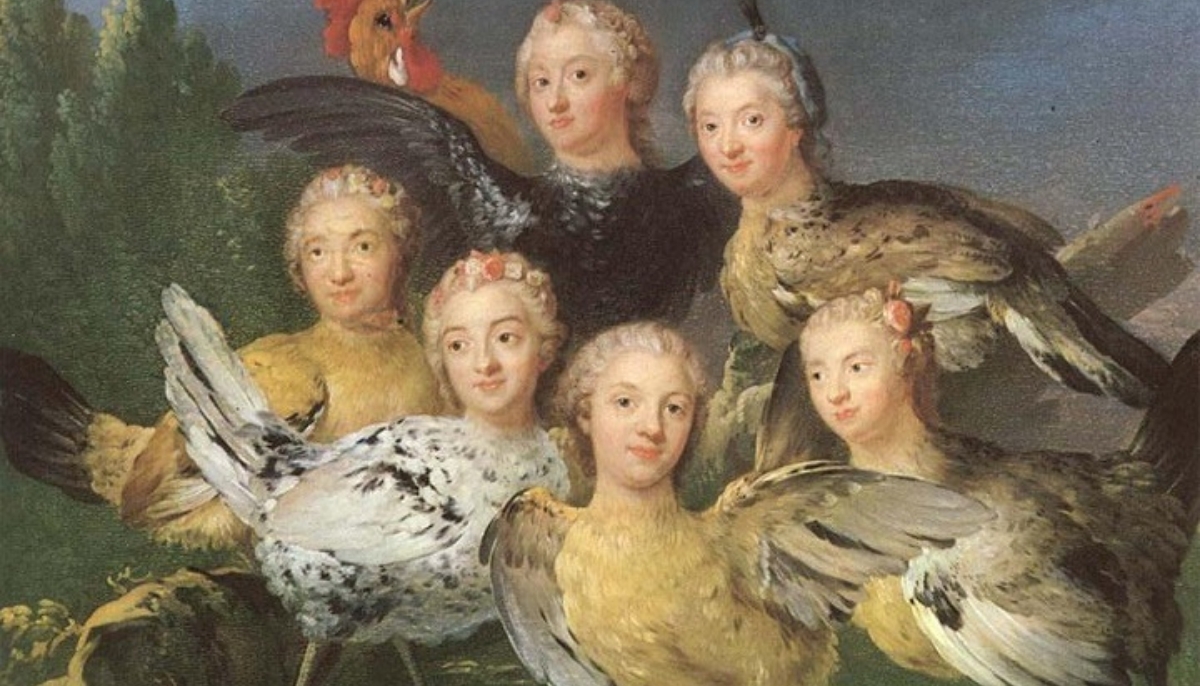Step into ancient Rome’s world and discover the city’s most powerful women – the Vestal Virgins. These women were more than just priestesses of the Temple of Vesta; they held the power to vote, buy land, free slaves, and even pardon the condemned.
But, their extraordinary privileges came at a great cost. Living a life of celibacy and virtue, they were constantly at odds with the lavish and sinful society around them.
It is said that their origins date back to the legendary Roman King Numa himself, long before the Republic was established. Brace yourself for a journey into the world of the enigmatic Vestal Virgins.
What is a Vestal Virgin?

The six Vestal Virgins of Rome were not only priestesses but also symbols of the revered pagan cult of Vesta, the goddess of home and family. Often depicted as a flame, the goddess embodied the warmth and protection of the household.
The cult of Vesta was fundamental to the Romans, and its influence extended far beyond the Temple’s walls. The eternal flame of Vesta tended to by the Vestals, represented the hearth of the Roman state. If the flame were ever to go out, it was believed to be an omen of impending doom for the city.
As the protectors of the sacred flame, the Vestal Virgins lived within the city in a grand house near the Temple of Vesta in the Roman Forum. They wore distinctive long white gowns, which symbolized their purity and virginity.
The Vestals took a vow of celibacy that lasted for thirty years, and breaking it was considered a grave offense punishable by death. Their lives were entirely devoted to the service of Vesta and the Roman state, and they were among the most respected and revered women in Rome.
- Interested in Roman-era paganism? Check out: Top 5 Fascinating Greco-Roman Mystery Cults
How to Become a Vestal Virgin

In the early days of Rome, acceptance into the order of Vestal Virgins was a privilege reserved only for the highest echelons of society. As there were only six Vestals at any given time, being selected to serve in the Temple of Vesta brought great honor and prestige to the family.
However, as time passed, Rome’s wealthy and influential families began to prioritize politically advantageous marriages over the honor of having a daughter serve as a Vestal.
As a result, the order gradually opened up to women from the lower classes of Roman society. To become a Vestal, a candidate had to be a high-born daughter of a Roman citizen and be free of physical defects and blemishes. The final selection was made by the Pontifex Maximus, the high priest of Rome, from a group of 20 eligible candidates.
What Were The Duties of the Vestal Virgins?

The 30-year obligation that Vestal Virgins undertook was divided into three distinct phases, each lasting ten years.
During the first decade of their service, the Vestals were devoted to learning and mastering the complex rituals and rites associated with the worship of Vesta. This included the study of sacred texts, the history of the Temple of Vesta, and the various ceremonial practices associated with the cult.
Once they had completed their learning period, the Vestals entered the second phase of their service, which focused on carrying out the daily work required to maintain the Temple of Vesta. This included preparing for and performing the many rites and ceremonies and the upkeep of many sacred objects within the Temple.
In the final decade of their service, the Vestals assumed the role of teachers, passing on their knowledge and expertise to the younger generations of Vestal Virgins who would follow in their footsteps. They also acted as matriarchs of the city, with many of their daily tasks revolving around the maintenance of the Temple and the sacred flame of Vesta.
The Flame of the Vesta
The most important role of the Vestal Virgins was to maintain the sacred fire of Vesta in Rome. Keeping this eternal flame alight was crucial; its extinguishment was considered a dire omen for the city.
This central duty parallels the Vestal Virgins’ ceremonial role at the Temple of Hera in Olympia, Greece. Here, they are symbolically responsible for lighting the Olympic flame, a ritual that marks the beginning of the Olympic Torch Relay.
This act links the modern Olympic Games to ancient traditions and emphasizes the Vestal Virgins’ enduring role as keepers of sacred flames.
Overseeing Roman wills and testaments
The importance of the Vestals within Roman society cannot be overstated. In addition to their religious duties, they were entrusted with the critical task of safeguarding the wills and testaments of Roman citizens. Their word was considered sacrosanct, and they were not required to give an oath before testifying.
This was a significant responsibility, as inheritance and family honor played a crucial role in the politics of the Republic.
For example, Octavian famously published Mark Antony’s will during the Civil War, which contained scandalous details about his affairs. This united the Roman public around the future of Augustus and solidified his power.
Would Vestal Virgins Be Buried Alive?
The Vestal Virgins of Rome were held in such high esteem that the penalty for breaking their vows of celibacy was severe. It was considered a betrayal of the order and the sacred goddess Vesta herself. The punishment for such a transgression was death, which was not a mere threat.
It was believed that Vestal Virgins who broke their vows would be stoned to death, a gruesome and humiliating punishment. However, as the Roman Republic transitioned to the Roman Empire, the punishment became even more severe. The guilty Vestal would be buried alive, ensuring that no blood was shed, as it was forbidden to spill the blood of a Vestal.
Only ten Vestals are recorded to have been executed this way, which is a testament to the order’s dedication. However, some historians believe some of these executions may have been politically motivated.
For instance, Domitian’s execution of four Vestals, which occurred during his reign, appears particularly suspicious.
Nevertheless, the fact remains that the Vestal Virgins were held to an incredibly high standard, and the penalty for failing to live up to that standard was severe.
Vestal Virgins Scandals
After 30 years of service, the Vestal women could live however they wanted. This included getting married, although many chose to continue their life of celibacy. Marrying a former Vestal was seen as highly prestigious by the virtuous Romans.
Throughout the thousand years of the institution, there have been several scandals. They mainly involve powerful men looking to subvert the 30-year obligation to bolster their self-image.
The Trial of the Vestal Virgins

In 115-113 BC, a scandal shook Rome as a slave named Manius testified against three Vestal Virgins.
He claimed they had broken their celibacy vows and promised him freedom in exchange for their sexual favors. The accused women were Aemilia, Licinia, and Marcia.
Manius specifically named Lucius Veturius as the man they had slept with, with Aemilia and Licinia having multiple partners.
During the first trial in 115 BC, Aemilia was found guilty and sentenced to death, but Licinia and Marcia were acquitted. This verdict caused an uproar in Rome as Manius had stated that the sexual activity of the Vestals was an open secret in high society, turning the case into a political issue.
A year later, the authorities were forced to reopen the case, this time with a stricter prosecutor. Licinia and Marcia, along with four of their lovers, were found guilty and sentenced to death by burial.
The scandal shook Roman society to its core and showed that even the Vestal Virgins were not above the law.
Marriage to Elagabalus

Elagabalus was a controversial figure in Roman history, known for his flamboyant behavior and unconventional ideas. He rose to power in 218 AD at the age of just 14 and immediately made waves in the conservative elite circles of Rome.
Elagabalus challenged traditional gender norms and would likely be described as transgender by modern standards. He rejected traditional Roman religion and elevated the sun god Sol Invictus, or Elagabal, as the supreme deity.
As the high priest of Elagabal, Elagabalus saw marrying a priestess of Vesta as a way to unite the two religions and produce god-like children.
Elagabalus took Aquilia Severa, the high priestess of the Temple of Vesta, as his second wife. However, the marriage was controversial and quickly caused an uproar among the conservative Roman elite.
Elagabalus was eventually persuaded to divorce Severa, but he quickly changed his mind and remarried her, remaining married to her until his assassination in 222 AD.
Elagabalus’ unconventional ideas and behavior earned him a reputation as one of the most unique emperors in Roman history. His brief reign remains a fascinating subject for historians and scholars today.
- Interested in Elagabalus? Check out our article on gay Roman Emperors
The End of Rome’s Vestal Virgins

Many Emperors saw Christianity as a unifying force that could help to stabilize the Empire, which had been plagued by political and social unrest for many years. As a result, they actively promoted the spread of Christianity and discouraged the practice of pagan religions.
The Vestal Virgins, as high priestesses of the pagan goddess Vesta, were particularly vulnerable to this trend. With the decline of paganism, their role as keepers of the eternal flame lost its significance, and their status as revered figures in Roman society began to wane.
As the Christian Church gained more power and influence in Rome, the Vestal Virgins’ temples and shrines were closed or converted into Christian churches. The Vestals themselves were gradually replaced by Christian nuns, who assumed many of their roles as caretakers of religious relics and symbols.
While the exact details of the Vestals’ disappearance from history are unclear, it is clear that their role in Roman society was greatly diminished by the end of the fourth century.
The once-mighty order of Vestal Virgins, who had played a crucial role in the religious and social life of Rome for centuries, had finally come to an end.






